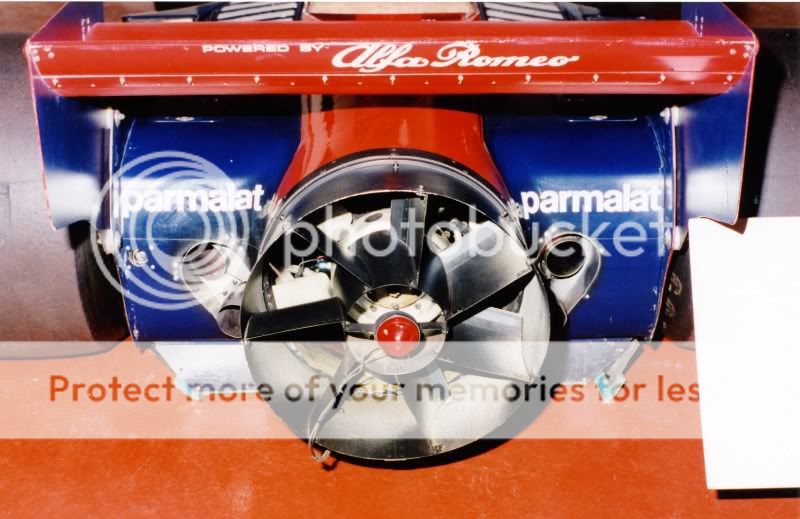A fan not the only change to the Brabham BT46 ?
#1

Posted 20 July 2001 - 09:18
http://www.motorraci...p78/78swe02.htm
...I always thought they just bolted a fan to the back of the car and let it loose but I see that the nose appears much for straight on this car than the regular BT46. Am I just imaging things or did they do this to allow some more air to the underbody of the car? Were there any other modifactions?
Advertisement
#2

Posted 20 July 2001 - 10:00
#3

Posted 20 July 2001 - 12:04
In the standard BT 46, you have radiators in the front wing, all width plus oil radiators on the sides in front of each rear wheel. Since forced air passed through a radiator fitted at top of the engine, the front wings were simplified and the radiator disappeared. And, as Darren already noted, the underside was sealed.
Yet a nice car anyway
#4

Posted 20 July 2001 - 13:05
He also says in this interview that Bernie retired the car the next GP due to a curious deal with the "english" teams (mainly Chapman and Tyrell) where Chapman was in the lead : BT46B withdraw against Bernie election.
Gordon said that Chapman was very affraid of the car.
And the point that came to mind is : if this fan was such a simple modification, why Chapman and the others were so affraid of it ? Why they could not do the same simple thing with the same spectacular result in a couple of weeks ?
My conclusion is the "upgrade" was probably a "little bit" more as a single fan quickly "scotched" on the back of the car ;)
Y.
#5

Posted 20 July 2001 - 14:14
I think it was relativelly simple to add a fan to a Lotus. In fact, there were rumors that Chapman already was developing a twin fan Lotus 79. It was also simple to be legal, just use more than 50% of the airflow to cool the radiators. There is an extra gain: since the cooling airflow is forced, a smaller size (area) is needed for the radiators.
The problem, as I see it was safety, as it was impossible to be in the back of the fan car.
#6

Posted 20 July 2001 - 18:27
#7

Posted 22 July 2001 - 14:41
Originally posted by fines
Cooling was always going to be a problem with the BT46, since it was originally developed with surface heat exchangers. When these failed to work properly, the car was fitted with the front-mounted radiators, but Murray wanted to get back to its original aerodynamic configuration, ie fully operational front wings. Hence the fan in the first place.
Mwah...... I think sucking the car to the road was the primary reason. The rest was just nice, but secondary.
Concerning the fear of Chapman: maybe he was afraid the cars with more power than the Cosworth-engined cars, like the Brabham-Alfa, had an advatage?
mat
#8

Posted 23 July 2001 - 12:43
Concerning the fear of Chapman: maybe he was afraid the cars with more power than the Cosworth-engined cars, like the Brabham-Alfa, had an advatage?
Of course. The fan takes power from the engine. You can afford it with a powerful one (the Alfa had the higher output of the whole field, at least a 'good' unit - 'Tigre' or 'Supertigre'). The advantage of the wing car concept was that it didn't need any power. But it was as much illegal as the fan in the spirit AND the letter of the rules. Skirts were moving parts, isn't it? And what was their *main* function, if not aerodynamic?
#9

Posted 23 July 2001 - 14:09
Originally posted by Patrick Italiano
The advantage of the wing car concept was that it didn't need any power.
Is that right? Doesn't a wing take power too, albeit not directly from the crankshaft, but by creating extra drag?
mat
#10

Posted 23 July 2001 - 15:57
Is that right? Doesn't a wing take power too, albeit not directly from the crankshaft, but by creating extra drag?
Yes, of course, but so does as well the suction created by the fan, while the wing's downforce doesn't need power to be built up.
#11

Posted 24 July 2001 - 07:00
Originally posted by Patrick Italiano
Yes, of course, but so does as well the suction created by the fan, while the wing's downforce doesn't need power to be built up.
So both take power. What would be more efficient, the fan, or the wings/venturi? A difference of course is that the fan is more or less independent of speed. I think that is an advantage.
mat
#12

Posted 24 July 2001 - 10:23
So both take power. What would be more efficient, the fan, or the wings/venturi? A difference of course is that the fan is more or less independent of speed. I think that is an advantage.
Well, the fan takes power in two ways: direcly from the engine AND it adds drag through the suction effect. The wing does it only in the latter way, thus it's more efficient.
But you're right about the speed-related effect. The wing produces maximum downforce when at maximum speed, i.e. in straight line (and, what's is better, in very fast corners - remember Depailler's death in Hockenheim in a flat out corner). As far as I understand Murray's fan, it's speed was proportionate to engine speed, not to car's.
Darren Galpin wrote in his article :
The fan was driven from the gearbox via a series of shafts and clutches
The fan was so effective, that the car could be seen to suddenly squat downwards when the throttle was blipped in the pits.
The first sentence could make one think it runs at final drive's speed, the second means that the fan is working when that car is at stop, which means connected to engine (i.e. to primary shaft), not to final drive.
In this case, you get more downforce than a wing in slow corners since you shift down and keep engine speed up. But it's a problem with the fan's inertia.
Darren, can you confirm?
#13

Posted 24 July 2001 - 11:02
#14

Posted 24 July 2001 - 11:49
However, "traditional" F1 have no fan, so don't cool down when stopped, unless external fans are used on the grid or in the box.
#15

Posted 24 July 2001 - 14:06
You say:
Originally posted by Patrick Italiano
Well, the fan takes power in two ways: direcly from the engine AND it adds drag through the suction effect. The wing does it only in the latter way, thus it's more efficient.
I'm not sure I understand what you mean by suction effect.
The fan is driven by the engine, and this takes power. This power is converted so to speak in an underpressure under the car, which creates downforce. The downforce itself creates some additional (machanical) friction, of course (Tyres, bearings). Is the suction effect the same as the underpressure?
In the case of downforce by wings/venturi's/groundeffect, the car is driven by the engine. As a result of the speed, underpressure is created below wings/the bottom of the car etc, and this creates downforce. And this downforce itself creates some additional friction.
In both cases energy from the engine is converted in downforce, by a fan driven by the engine, or by the (wings/underbody of the) car, which is driven by the engine.
So I don't see the difference, apart from the point which is the more efficient way of creating downforce at what speed. Obviously the fan works better at lower speeds, but perhaps the downforce is not really needed then. Do you think at lower speed downforce is less useful? Or was a disadvantage of the wingcars they were retlatively low on downforce at low speeds? BTW, Why did the BT46B blow the Lotus 79 away at Anderstorp? Apperantly it was more efficient, but maybe I'm jumping at conclusions?
mat
#16

Posted 24 July 2001 - 14:47
My point is that the overall effect on aerodynamics of a fan is in some way also detracting penetration capabilities of the car. The flow around it is perturbated, the skirts prevent the airflow from passing cleanly under the car, no doubt the air outlet of the fan creates swirls,...
This is maybe in part compensated by the reduced frontal area obtained in placing the radiator horizontaly over the engine rather than in the front wings. This would need accurate research to estimate the parameters involved.
More downforce at low speed is of course an adavantage. No doubt that if you compare a F1 to a street car, the F1 will get much more advantage on the street car in long, fast bends than, say, at the Loews bend.
I think that in 1978, the wing car concept was still underdevelopped and not fully understood. In such conditions, the fan was a more straightforward solution.
#17

Posted 25 July 2001 - 01:08
The car was described as looking like the box it came in.

Check out this web site for more on the Can-Am, the last unlimited racing series:
http://www.primenet....west/can-am.htm
#18

Posted 26 June 2010 - 17:03
#19

Posted 27 June 2010 - 03:02
Here is a pic of the BT46B...
http://www.motorraci...p78/78swe02.htm
...I always thought they just bolted a fan to the back of the car and let it loose but I see that the nose appears much for straight on this car than the regular BT46. Am I just imaging things or did they do this to allow some more air to the underbody of the car? Were there any other modifactions?
Shame we can no longer see the original pic in this post but the prototype BT46, when launched, featured the same nose as the BT46B fan car, however the original heat exchangers on the prototype, see light coloured panels in the bodywork, did not work as planned so the second version of the BT46, which raced in 1978, had traditional radiators fitted in the nose and on the sides of the car.
When the third version of the BT46 came out, the BT46B fan car, the radiator that had been used in the nose was replaced by a much smaller radiator placed horizontally over the engine in the airstream of the fan.
All of this must have played havoc with the balance of the car though both race versions were to take the checkered flag although the conventional one only after Andretti had been penalised a minute at Monza.
A fourth version of the BT46 (BT46C) also appeared for a single practice session at the 1978 Austrian GP featuring the chisel nose of the BT46 prototype and BT46B Fan Car but with two (VW Golf) radiators mounted flush with the bodywork behind the front wheels, two cars furthest away in the picture.
What I had not fully appreciated until today was that some form of the original heat exchangers were used through out the 1978 season, but do not seem to have ever been used since anywhere else since, see the diagonal light coloured surfaces on top of the engine cover.
Edited by arttidesco, 27 June 2010 - 03:11.
#21

Posted 27 June 2010 - 17:46
Those are the engine air intakes
Seem a mighty strange shape for intakes but I'll take your word for it :-)
#22

Posted 27 June 2010 - 20:13
Seem a mighty strange shape for intakes but I'll take your word for it :-)
no, thats right - you are looking down on the filter gauze above the intake trumpets of the flat 12. the 'airbox ', as such, is just the plenum chamber below the filter. there's no ram intake.
#23

Posted 27 June 2010 - 21:29
So I really no longer believe the BT46 ran with any form of the original heat exchangers :-)
Edited by arttidesco, 27 June 2010 - 21:31.
#24

Posted 28 June 2010 - 20:57
#25

Posted 28 June 2010 - 21:42
ok, but these are not the same thing - the bt46 filter is flat - and flush with the body. very common these days.
I got it ... eventually
#26

Posted 22 April 2011 - 19:10

It is a rare front view of the BT46C during practice for Austria '78
#27

Posted 23 April 2011 - 00:26

Uploaded with ImageShack.us
#28

Posted 23 April 2011 - 00:49

#29

Posted 23 April 2011 - 06:05
#30

Posted 23 April 2011 - 08:58
I know one of the concerns, I think voiced by Andretti, was the fact in the wet it would throw up huge rooster tails. Did the fan car ever test at Donington in the wet and therefore was this arguement actually based on fact ?
That argument was nonsense, as far as I've always known. Andretti and others complained that the cars threw up stones and dust and soforth, but that was political: they wanted to get the car banned any which way possible. I can remember Andretti admitting it was all political hooha. Gordon Murray himself said that any debri was thrown to the side of the car, not the back, and with a very low exit speed to boost.
So, again, AFAIK: the Brabham fancar was not dangerous to other cars or drivers in any way.
#31

Posted 23 April 2011 - 09:45
Well, I remember a shot from the TV coverage showing John Watson spinning off, and there was a column of red dust blown out of the back, right across the track!Gordon Murray himself said that any debri was thrown to the side of the car, not the back, and with a very low exit speed to boost.
#32

Posted 23 April 2011 - 11:12








#33

Posted 23 April 2011 - 11:52
Well, I remember a shot from the TV coverage showing John Watson spinning off, and there was a column of red dust blown out of the back, right across the track!
Quite possibly. But think of this: if the air escaping a jet-engine is greater than the build up pressure within, there is no or nearly no thrust... The fancar was not intended to be blown forward! The fan was intended to suck the car to the ground. So there was force needed, no quick air out of the back.



















